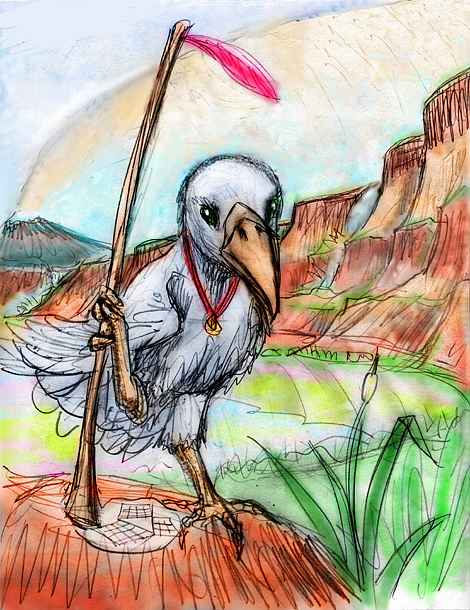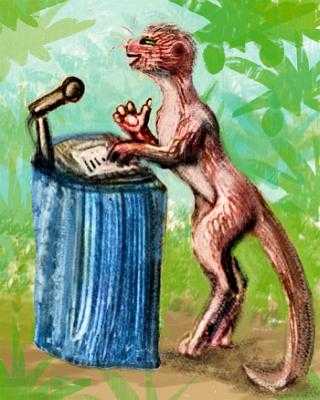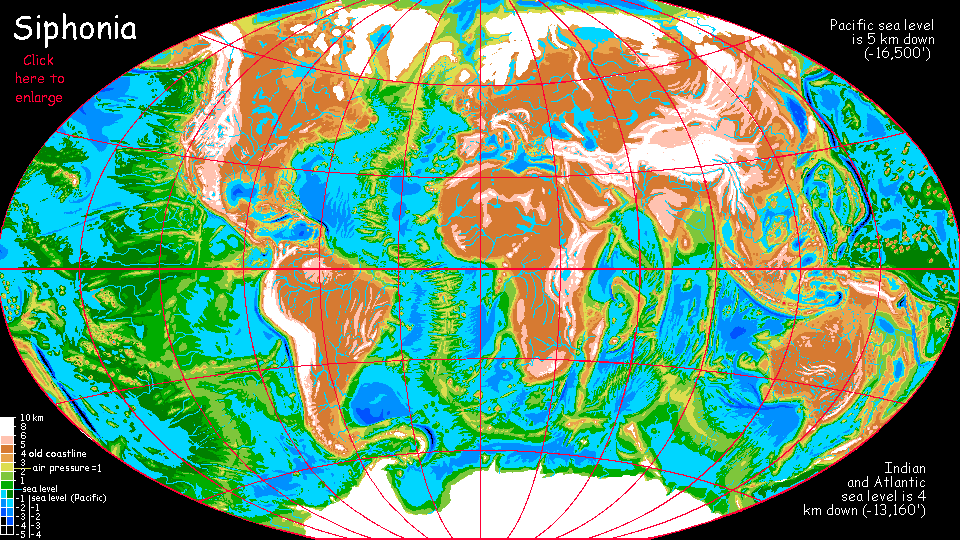World Dream Bank
home -
add a dream -
newest -
art gallery -
sampler -
dreams by
title,
subject,
author,
date,
places,
names
Siphonian Evolution
by Chris Wayan, 2006-9
Siphonia - map - regional tours - People, Creatures - Evolution - (don't click yet: Gazetteer - Glossary) - more worlds? Planetocopia!
THE OTHER SINGULARITY
As I write this, most humans still think of themselves as the only people on Earth. A few do realize this solitude may not last much longer; machine intelligence rises ever more steeply toward a peak where change is so fast and unexpected that we cannot see ahead: the Singularity. Some remain skeptical, but I believe it; I've spent a decade designing models of future worlds, but barring a technocrash, I can't see any way the future past 2100 (and probably 2050) can be imagined by contemporary humans. We're just not smart enough.
But take a long view. We're already deep in a biological singularity. For four billion years life was aware of its immediate needs, but little more; but starting with some of the more social dinosaurs, then their avian descendants, then cetaceans, elephants and apes, creatures aware of themselves and others have been proliferating--all in the last 1-2% of Earth's history. Our notion of punctuated equilibrium (that life is deceptively stable in stable conditions but scrambles to respond to swift environmental change) rarely gets pushed far enough. Few of us remember that the environment includes us--all those unpredictable creatures. It's easy for humans to focus on one narrow aspect of this lesson, and think we are the catalyst for change these days--simply because we've done so much visible damage. But we're just one result of the Intelligence Explosion, not its cause. Dozens of species have many of the crucial five traits needed to build a civilization...
- a brain of a certain complexity (not size--avian brains are far more efficient per ounce)
- language (the sense of self may reside more in the word "I" than in a lobe of the brain--or a soul)
- sociability (giant squid and orangutans are bright but may be too solitary to develop civilizations)
- hands (or tentacles, or dexterous trunks, or really clever tongues...)
- a habitat with raw materials for tools and fire (tundra and deep sea are poor cradles for civilization)
Notice that Trait 1 is all it really takes to grow from from an animal to a person. Traits 2-3 foster culture; Traits 4-5 foster technology.
Our world is hand-poor, but brains aren't an ape monopoly (elephants, dolphins, wolves, whales), nor a mammalian one (ravens, parrots, velociraptors), nor even a vertebrate one (octopi and giant squid). If Siphonia seems over-rich in intelligent creatures, remember Terra's full spectrum--a couple of dozen species are already self-aware or on the brink (skeptical? Read the new ethology! And did you count marine species or were you terracentric again?) Human, chimp, bonobo, gorilla, orangutan, bottlenose dolphin, orca, sperm whale, two species of African elephant, Indian elephant, wolf, raven, brown/grizzly and polar bears, half a dozen species of large parrot, macaws and cockatoos, large octopi and giant squid. Add other cetaceans and manatees and midsize parrots and you could easily reach three dozen). And those are only the ones that survived our brutal, unopposed rise (due, I'm arguing, more to that deadly, rarer ingredient in our intelligence-mix: tool-ready hands). Before the human holocaust there were probably fifty to a hundred. Certainly the most recent 1% of Earth's history saw hundreds of abortive smarties--after billions of years of zero. Alone? Only in our dreams! We're not alone at all. We're one petal of a sudden bloom.
What caused this sudden flowering, a hundred million years ago? Its first sprout could have been anything: courting displays, a feedback loop between genders of a species, like bowerbird art; or a simple arms race between a predator and its prey, like spermwhale and giant squid; or just pack cooperation leading to social smarts, like velociraptors or wolves; or the leisure explosion when flowering plants evolved high-energy nectar, fruit and nuts, freeing up playtime. Whatever it was, the end result was a "rising sea" effect--once any creature develops any of these intelligent traits, those who smarten up, follow the innovators' lead into the new behavioral territory, have a competitive advantage.
Whatever the cause, it's gone from a trickle to a torrent. But like the insecure adolescents we are, humans act hypercritical of our rivals--we lash out at those who might teach us a thing or two. Cattle and rats aren't at risk of extinction; but nearly all the species on my list above are. I believe the Sixth Extinction, the massacres we've perpetrated for ten thousand years, have masked the Intelligence Singularity--temporarily.
Siphonia reveals it. Revels in it.
SAPIOGENICITY OF THE BIG SLURP
Now, the premise of Siphonia is that both the human civilization and Earth's environment get profoundly upset in a single inexplicable day. Aliens slurp up nine-tenths of our seas. As punctuated equilibrium goes, it's an exclamation point! The aftershocks are still reverberating ninety thousand years later. On many of the regional tours I've emphasized the geographic and ecological consequences; but Siphonia's just as much about the evolutionary scramble that follows; and my view of this has been shaped by my perception of an Intelligence Singularity. Not exclusively; there are other factors encouraging sapiogenesis (the rise of intelligence) on Siphonia. Here are four:
-
Siphonia's land area has more than doubled. And much of that new land is greener, for it's mostly maritime or coastal; though Siphonia has big deserts and tundras, overall land biomass is at least as high, probably higher. Rich new habitats all over! Life has scrambled spatially to exploit the new turf, but also behaviorally and genetically, into radical new niches. The Ice Age was an ecological slap in the face, yet it created us. Why be surprised that the Big Slurp--an ecological bonanza for land animals--also stimulated sapiogenesis? A sapiogenesis that I believe was already well underway.
-
90,000 years of exposure to human civilization. Memes spread slowly across species lines, but they do spread. Intelligent creatures can and do observe the advantages of tool use, language and so on. Until recently it's been too dangerous for wild animals to interact with us, but now that it's safer, they're re-entering human lands. My city has flocks of feral parrots and wild ravens exploiting human heat sources, food and even updrafts from skyscrapers. Coyotes have been seen for the first time in a century on my hill. Whales, dolphins and sea lions have been re-exploring the bay. Koko the signing gorilla lives nearby--only ten km from puma habitat. The mixing has already begun. Now extrapolate for eons! They'll pick it up. And those that do will have an advantage.

-
Most of Siphonia's seas lie 4-5 km below the old sea level. The dense air of these deep basins can support fliers as heavy as 25 kg (55 lbs). For the first time in Earth's history, intelligent life can fly under its own muscle power.
Even our parrots are as bright as chimps, though it took until this decade for the evidence to finally overcome our smug mammalocentrism. And they manage it with brains weighing only ounces. Bird brains (despite human insults) beat mammal brains for efficiency--and by a wide margin!
Megaparrots average only 15 kg (33 lbs), but that's quite large enough for them to have brainweights approaching a pound. They're quite as intelligent as a human--more so, if you ask them. These parrots are imposing creatures in other ways as well: brilliantly colored, with much deeper (but still piercing) voices, and wingspans of 3 meters (10').
They have close cousins in the Pacific basins: crested white cockatoos. The Agassiz and Pacific Deeps have air 20% denser than in the Atlantic or African Deeps, so megatoos run even larger (wingspans up to 4 m) and perhaps more intelligent. They certainly think so.
Equally imposing are some more distant cousins: blue ravens. They're even less recognizable, for in these sweltering basins, black feathers are a sun-absorbing disadvantage; as ravens spread into the Deeps and grew, they lightened in color, ending up looking more like their close cousins the jays: various mixtures of gray, blue and white.
But they're unmistakably ravens: huge heads, rich but hoarse voices, the playfulness tinged with a dark irony... really, they haven't changed a bit. A useful tonic to anyone grown tired of parrots' loud good cheer (punctuated by equally loud prima-donna tantrums).

-
But fliers aren't the only creatures who have grown larger, with startling consequences for brain size. For an example I'll use the species you're most likely to meet here in the Deeps: a newly evolved people who cope with the heat and humidity in a different way, by hardly coming out of the water, in the day at least. You see them in every port and river town: big wet furry things chirping at you and wiggling their whiskers. They're descendants of giant freshwater Amazonian otters, of course.
Their quick evolution was one of those unpredictable consequences of radical environmental change. Recent studies show that the size of animals and the number of species (and probably total biomass, too) correlate well with the oxygen content of the air--currently 21%. But in the last billion years alone, it's ranged from 13 to 30%! Siphonia's air isn't much richer than Earth's today, but all those deep abyssal rainforests do produce a lot; Siphonia's air has 23%, or one-tenth more. However, that's just a percentage. In the Pacific Deeps, air pressure's so high that 70-80% more oxygen is available--a bigger change than animal life has seen since brains evolved!
All that extra oxygen makes it much easier for an animal to grow larger--OR to grow larger specialized, oxygen-hungry organs. Like brains! They're the costliest organ of all, pound for pound, measured in both calorie and oxygen consumption. In an environment where food isn't too hard to get--and these exuberant jungle coasts sure qualify--it turns out that supercharged air has freed many nonflying species to grow much larger and more intelligent. Amazonian otters, already big and smart, apparently crossed a crucial threshhold: social intelligence, the ability to understand, predict, and influence other creatures' behavior, became more important as they got less predictable. A spiral of brain-growth ensued, rather quickly tripling brain-size... precisely as it did to humans, dolphins and elephants on Earth. And not to otters alone! There's a whole bestiary of such creatures... except they're sentient beings now, so we'd better call it a Sentiary.

TOUR SIPHONIA! Click a region above, or choose from:
- Arctic Valleys, sea level to 3 km high
- Atlantic Ocean (our N. & S.E. Atlantic), sea level
- African Ocean (S. Atlantic & W. Indian Ocean), sea level
- Bengal Sea (N. Indian Ocean), sea level
- Australian Ocean (E. Indian Ocean, Tasman Sea), sea level
- Davis Sea (S. Indian Ocean), sea level
- Anzac Basins (N.Z. to Australia), 0.5-2.5 km high
- Mornington Sea (S.E. Pacific) sea level
- Nazca Seas (E. Pacific), sea level to 1 km high
- Agassiz Basin (S. Pacific), 1 km down
|
|
- Pacific Ocean (N. Pacific), 1 km down
- East Asian Seas, 1-3.5 km high
- Javan Seas, 0.5-2.5 km high
- Australia, 4-5 km high
- Amazon Highlands and Andean Cap, 4-8 km high
- African Highlands, 5-6 km high
- Antarctic Cap, 4-5 km high (no, not 7-8!)
- European and Siberian Highlands, 4-6 km high
- Caribbean Lakes, 2-5 km high
- Canadian Highlands, 4-6 km high
|
Siphonia's homepage - map - peoples of Siphonia - Siphonia's evolution - Gazetteer
LISTS AND LINKS: More worlds? Planetocopia! - dreams of other worlds - ecology - climate change - evolution - natural disasters - terraforming - sculptures and 3D art -
World Dream Bank homepage - Art gallery - New stuff - Introductory sampler, best dreams, best art - On dreamwork - Books
Indexes: Subject - Author - Date - Names - Places - Art media/styles
Titles: A - B - C - D - E - F - G - H - IJ - KL - M - NO - PQ - R - Sa-Sk - Sl-Sz - T - UV - WXYZ
Email: wdreamb@yahoo.com - Catalog of art, books, CDs - Behind the Curtain: FAQs, bio, site map - Kindred sites